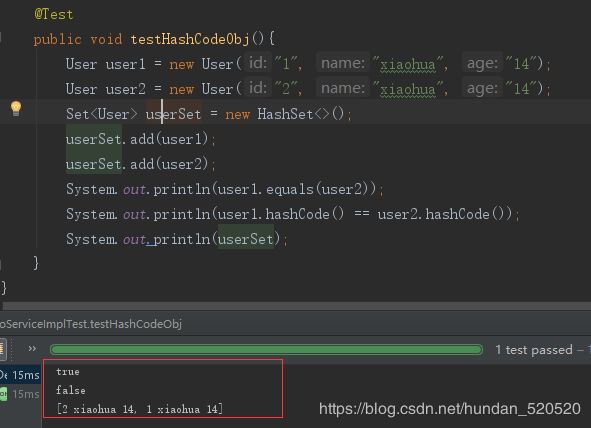【转】Java 如何重写对象的 equals 方法和 hashCode 方法
一、需求
对比两个对象是否相等。对于下面的 User 对象,只需姓名和年龄相等则认为是同一个对象。
二、解决方案
需要重写对象的 equals 方法和 hashCode 方法
public class User {
private String id;
private String name;
private String age;
public User(){}
public User(String id, String name, String age){
this.id = id;
this.name = name;
this.age = age;
}
@Override
public String toString() {
return this.id + " " + this.name + " " + this.age;
}
@Override
public boolean equals(Object obj) {
if(this == obj){
return true;//地址相等
}
if(obj == null){
return false;//非空性:对于任意非空引用x,x.equals(null)应该返回false。
}
if(obj instanceof User){
User other = (User) obj;
//需要比较的字段相等,则这两个对象相等
if(Objects.equals(this.name, other.name)
&& Objects.equals(this.age, other.age)){
return true;
}
}
return false;
}
@Override
public int hashCode() {
int result = 17;
result = 31 * result + (name == null ? 0 : name.hashCode());
result = 31 * result + (age == null ? 0 : age.hashCode());
return result;
}
}
三、测试
创建两个对象,名字和年龄相等则对象 equals 为 true。
@Test
public void testEqualsObj(){
User user1 = new User("1", "xiaohua", "14");
User user2 = new User("2", "xiaohua", "14");
System.out.println((user1.equals(user2)));//打印为 true
}
四、为什么要重写 equals 方法
因为不重写 equals 方法,执行 user1.equals(user2) 比较的就是两个对象的地址(即 user1 == user2),肯定是不相等的,见 Object 源码:
public boolean equals(Object obj) {
return (this == obj);
}
五、为什么要重写 hashCode 方法
既然比较两个对象是否相等,使用的是 equals 方法,那么只要重写了 equals 方法就好了,干嘛又要重写 hashCode 方法呢?
其实当 equals 方法被重写时,通常有必要重写 hashCode 方法,以维护 hashCode 方法的常规协定,该协定声明相等对象必须具有相等的哈希码。那这又是为什么呢?看看下面这个例子就懂了。
User 对象的 hashCode 方法如下,没有重写父类的 hashCode 方法
@Override
public int hashCode() {
return super.hashCode();
}
使用 hashSet
@Test
public void testHashCodeObj(){
User user1 = new User("1", "xiaohua", "14");
User user2 = new User("2", "xiaohua", "14");
Set<User> userSet = new HashSet<>();
userSet.add(user1);
userSet.add(user2);
System.out.println(user1.equals(user2));
System.out.println(user1.hashCode() == user2.hashCode());
System.out.println(userSet);
}
结果

显然,这不是我们要的结果,我们是希望两个对象如果相等,那么在使用 hashSet 存储时也能认为这两个对象相等。
通过看 hashSet 的 add 方法能够得知 add 方法里面使用了对象的 hashCode 方法来判断,所以我们需要重写 hashCode 方法来达到我们想要的效果。
将 hashCode 方法重写后,执行上面结果为
@Override
public int hashCode() {
int result = 17;
result = 31 * result + (name == null ? 0 : name.hashCode());
result = 31 * result + (age == null ? 0 : age.hashCode());
return result;
}
所以:hashCode 是用于散列数据的快速存取,如利用 HashSet/HashMap/Hashtable 类来存储数据时,都会根据存储对象的 hashCode 值来进行判断是否相同的。
六、如何重写 hashCode
生成一个 int 类型的变量 result,并且初始化一个值,比如17
对类中每一个重要字段,也就是影响对象的值的字段,也就是 equals 方法里有比较的字段,进行以下操作:
- a. 计算这个字段的值 filedHashValue = filed.hashCode();
- b. 执行 result = 31 * result + filedHashValue;
七、为什么要使用 31
看一看 String hashCode 方法的源码:
/**
* Returns a hash code for this string. The hash code for a
* {@code String} object is computed as
*
* s[0]*31^(n-1) + s[1]*31^(n-2) + ... + s[n-1]
*
* using {@code int} arithmetic, where {@code s[i]} is the
* ith character of the string, {@code n} is the length of
* the string, and {@code ^} indicates exponentiation.
* (The hash value of the empty string is zero.)
*
* @return a hash code value for this object.
*/
public int hashCode() {
int h = hash;
if (h == 0 && value.length > 0) {
char val[] = value;
for (int i = 0; i < value.length; i++) {
h = 31 * h + val[i];
}
hash = h;
}
return h;
}
可以从注释看出:空字符串的 hashCode 方法返回是 0。并且注释中也给了个公式,可以了解了解。
String 源码中也使用的 31,然后网上说有这两点原因:
-
原因一:更少的乘积结果冲突
31是质子数中一个“不大不小”的存在,如果你使用的是一个如2的较小质数,那么得出的乘积会在一个很小的范围,很容易造成哈希值的冲突。而如果选择一个100以上的质数,得出的哈希值会超出int的最大范围,这两种都不合适。而如果对超过 50,000 个英文单词(由两个不同版本的 Unix 字典合并而成)进行 hash code 运算,并使用常数 31, 33, 37, 39 和 41 作为乘子,每个常数算出的哈希值冲突数都小于7个(国外大神做的测试),那么这几个数就被作为生成hashCode值得备选乘数了。
所以从 31,33,37,39 等中间选择了 31 的原因看原因二。 -
原因二:31 可以被JVM优化
JVM里最有效的计算方式就是进行位运算了:
左移 << : 左边的最高位丢弃,右边补全0(把 << 左边的数据*2的移动次幂)。
右移 >> : 把>>左边的数据/2的移动次幂。
无符号右移 >>> : 无论最高位是0还是1,左边补齐0。
所以 :31 * i = (i << 5) - i(左边 31*2=62,右边 2*2^5-2=62)- 两边相等,JVM就可以高效的进行计算啦。。。